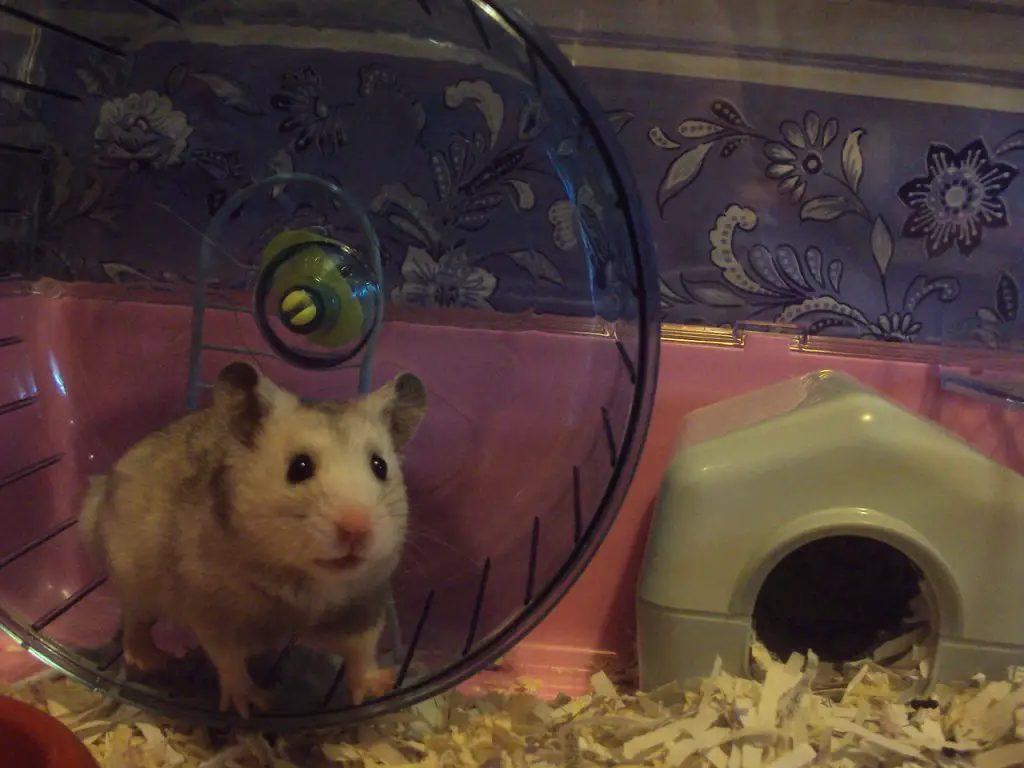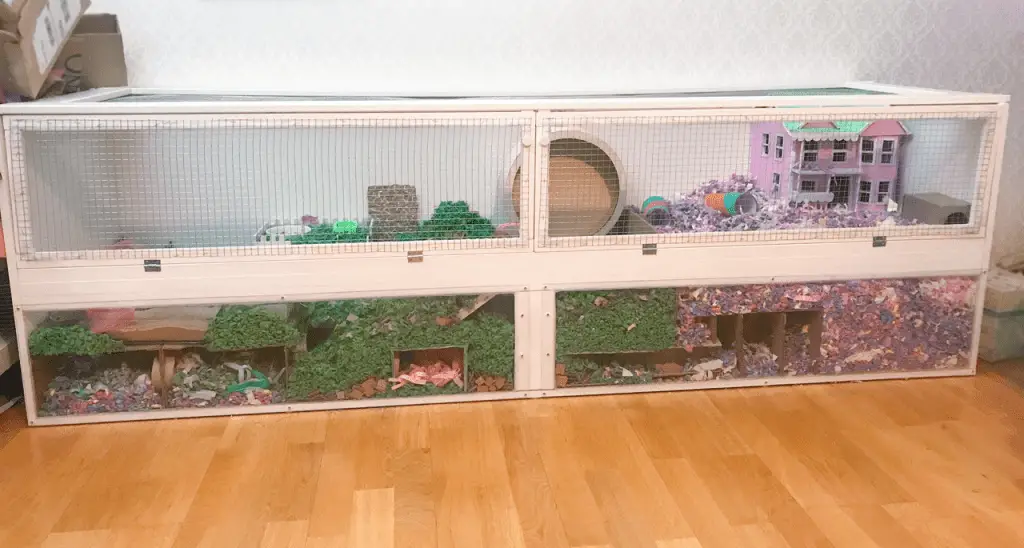Syrian hamsters are a popular small pet. They can be kept in a variety of different habitats, including cages, tanks, and even rooms.
When it comes to choosing a tank for your Syrian hamster, there are a few things you need to keep in mind.
In this blog post, we will discuss whether a 40-gallon tank is suitable for a Syrian hamster.
Key Takeaway
- A 40-gallon tank is suitable and even preferable for a small Syrian hamster as it provides ample room for the hamster to exercise and explore, enhancing its quality of life.
- A Syrian hamster should ideally have an enclosure that offers at least 450 square inches of floor space, which generally equates to a 40-gallon tank or larger.
Is a 40-Gallon Tank Suitable For a Small Syrian Hamster?

A 40-gallon tank is suitable for a small Syrian hamster. However, you will need to provide your hamster with plenty of toys and things to keep it entertained. A smaller tank may be more appropriate if you do not have the space for a larger one.
As a rule of thumb, you should always get the biggest tank you can afford and have space for. However, sometimes circumstances dictate that a smaller tank is necessary. If you find yourself in this situation, don’t despair! A small Syrian hamster can be perfectly happy in a small tank – as long as it is set up correctly.
Here are some tips for setting up a small tank for your Syrian hamster:
– The first thing you need to do is make sure the tank has plenty of ventilation. Good ventilation is essential for any hamster cage, but it’s even more important in a small cage where there is less air circulation. Make sure the mesh on the top of the cage is tight and there are no gaps around the sides.
– The next thing to consider is the floor space. A small Syrian hamster needs at least 12 square inches of floor space, so make sure the cage you choose is big enough.
– The third thing to think about is the height of the cage. A small Syrian hamster needs a minimum of 12 inches of height, so again, make sure the cage you choose is tall enough.
– Finally, you need to make sure there are no sharp edges or corners in the cage. This is important for any hamster cage, but it’s even more important in a small cage where your hamster could easily hurt itself on a sharp edge or corner. Choose a tank with rounded corners and smooth edges.
How Many Gallon Tank Should a Hamster Have?

The size of the tank really depends on the size of your hamster. A good rule of thumb is to give them at least ten gallons per inch of body length. So, if your hamster is two inches long, it should have at least a twenty-gallon tank. Of course, bigger is always better when it comes to giving your furry friend some extra space to roam around.
You can keep as many hamsters in a tank as you want, but it is important to make sure that they have enough space to exercise and play.
Hamsters are very active creatures and need plenty of room to run around. If you have a small tank, it is best to only keep one or two hamsters in it. Otherwise, your hamsters may become stressed and unhappy.
The tank should have a lid that is escape-proof, as hamsters are excellent climbers and escape artists. The tank should also have a water bottle and food dish. The bottom of the tank can be lined with newspaper, carefresh bedding, or aspen shavings.
Hamsters like to dig because it’s a natural instinct for them. In the wild, hamsters build their burrows by digging underground. This gives them a place to hide from predators and keep their food safe. Digging is also a great way for hamsters to get some exercise. Hamsters are very active creatures, and they need to burn off a lot of energy every day.
A wheel is also recommended, as hamsters love to run! Finally, add some toys for your hamster to play with, such as tunnels or chew toys says Hamsters101. By following these guidelines, you will create the perfect home for your furry friend!
Are Aquariums OK For Hamsters?
It is okay to keep a hamster in a fish tank or an aquarium, as long as they are in the proper size and have all the required accessories. Hamsters are nocturnal animals, so an aquarium with a lid that locks is the best option. Glass or plastic tanks are fine, as long as they’re escape-proof. The minimum size for a hamster tank is 24” x 12” x 12”, but bigger is always better.
You’ll also need to add some bedding to the bottom of the tank. Cedar and pine shavings are not recommended because they can be harmful to your hamster’s respiratory system. Instead, use recycled paper bedding or carefresh bedding. Be sure to avoid any bedding that’s been treated with chemicals or perfumes.
Your hamster will also need a water bottle and a food bowl. The water bottle should be attached to the side of the tank so it can’t be tipped over, and the food bowl should be heavy enough that your hamster can’t carry it off.
Finally, you’ll need to add some toys and hiding places for your hamster. Hamsters like to burrow, so adding a tunnel or two is a good idea. You can also add a wheel for exercise, but be sure it’s the right size for your hamster – too small and they could get injured, too big and they might not be able to use it effectively.
Can I Place Multiple Syrian Hamsters in a 40-gallon Tank?
No, it is not advisable to house multiple Syrian hamsters together in a 40-gallon tank as they are solitary animals and can become aggressive towards each other.
Syrian hamsters, also known as golden hamsters, are known for their solitary nature.
Unlike some dwarf hamsters, Syrians prefer to live alone and can become territorial and aggressive if forced to share their habitat with others.
Even in a large 40-gallon tank, placing multiple Syrian hamsters together can lead to fights, injuries, or even death.
Each Syrian hamster should have its own separate living space where it can eat, sleep, and play without the stress of another hamster invading its territory.
While it might seem like a larger space could accommodate multiple hamsters, Syrian hamsters simply do not tolerate the presence of others of their kind, regardless of the size of the enclosure.
What Happens If a Hamster Cage Is Too Small?
If a hamster cage is too small, the hamster may become stressed and anxious. This can lead to health problems such as poor appetite, weight loss, and decreased activity levels.
A small cage can also cause behavioral problems such as increased aggression or chewing on bars. If you think your hamster’s cage is too small, consider upgrading to a larger size.
With all of that in mind, let’s take a look at some of the best cages for hamsters on the market. The first option is the Habitrail Ovo Home (check the price on amazon.com). This cage is perfect for small animals like hamsters, and it comes with everything you need to get started – including a water bottle and food dish. It’s also easy to clean, and the wire floors are covered with a soft material to protect your hamster’s feet.
If you’re looking for something a little bigger, the Ferplast Hamster Cage (check the price on amazon.com) might be a good option. This cage is spacious and comes with plenty of room for your hamster to run and play. It also has a deep base that’s perfect for storing bedding and other supplies. And like the Habitrail Ovo Home, it’s easy to clean and has wire floors that are covered with a soft material.
Finally, if you’re looking for the ultimate in luxury for your hamster, take a look at the Savic Hamster Haven XL (check the price on amazon.com). This huge cage includes everything your hamster could possibly need – from a water bottle and food dish to a wheel and exercise ball. It also has multiple levels for your hamster to explore, and the wire floors are covered with soft fabric to protect their feet.
FAQs
Q: How large should a tank be for a Syrian hamster?
A: The minimum recommended tank size for a Syrian hamster is 40 gallons. However, bigger is always better when it comes to providing a comfortable and enriched habitat for your pet.
Q: Why is a 40-gallon tank recommended for a Syrian hamster?
A: Syrian hamsters are the largest of all hamster breeds and require a larger living space to accommodate their size and natural behaviors. A 40-gallon tank allows the hamster to have enough space to move around, exercise, and have plenty of toys and enrichment.
Q: Can I use a different type of cage for my Syrian hamster?
A: While a 40-gallon tank is the recommended option, you can also use other types of cages as long as they meet the appropriate size requirements. Make sure that the cage provides ample space for the hamster to comfortably move around and engage in natural behaviors.
Q: What other factors should I consider when setting up a tank for my Syrian hamster?
A: In addition to the tank size, it is important to consider ventilation, accessibility for cleaning, and safety features such as secure locks to prevent any potential escapes. Provide suitable bedding, hiding spots, exercise wheels, and toys to keep your hamster happy and entertained.
Q: How often should I clean the tank for my Syrian hamster?
A: It is important to clean the tank regularly to maintain a clean and healthy environment for your hamster. Spot clean daily by removing any soiled bedding and uneaten food. A thorough clean, including changing the bedding and washing the tank with mild soap and water, should be done every 1-2 weeks.
Q: What type of bedding should I use in the tank?
A: Choose a bedding material that is safe for your hamster and promotes good health. Aspen wood shavings and paper-based beddings are popular choices. Avoid cedar and pine shavings, as the strong aroma can be harmful to the hamster’s respiratory system.
Q: How can I ensure my Syrian hamster’s tank is escape-proof?
A: To make sure your hamster cannot escape from their tank, ensure there are no gaps or openings that they can squeeze through. Use a secure lid or cover that is specifically designed for hamster tanks and check it regularly for any signs of wear and tear.
Q: Can I add any accessories or toys to my Syrian hamster’s tank?
A: Adding accessories and toys to your Syrian hamster’s tank is highly encouraged. Provide an exercise wheel, tunnels, chew toys, and hiding spots to keep your hamster active and mentally stimulated. However, ensure that all toys and accessories are hamster-safe and do not have any small parts that could be swallowed or cause harm.
Conclusion and final thoughts
After discussing the various factors to consider when choosing a tank size for your small Syrian hamster, it is clear that a 40-gallon tank may not be the most suitable option.
While it may seem like a spacious and affordable choice, there are important considerations such as ventilation, enrichment, and cleaning that cannot be overlooked.




